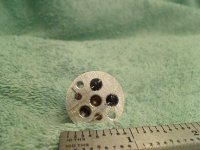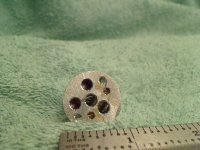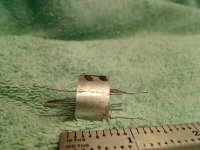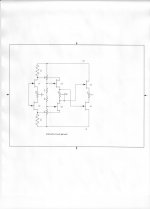Sorry everyone. Post #391 was a glitch.
Brad, it sounds to me (especially the counter-effect cooling had on the intensity of the emission) as if it was actually IR emission not adequately filtered in front of the CCD.
Did they verify the wavelength?
George
I think the material, initially probably reported at a session of SPIE or some such, is in Jim Janesik's big book about CCDs, which I have in storage somewhere. It was definitely not energy from without getting in. The magnitude of the emission was still small --- bear in mind that they were getting down to a few charges per potential well/pixel in times of order an hour.
And yes, when I said "light" I was speaking loosely: it was probably emission of photons near the bandgap energy at that temperature. Maybe the reason it may have gotten worse at operating temperature (~100 K iirc) is that fast electrons hitting cold lattices tend to do funny things. Of course it would have been easier to see the excess with the dark current elsewhere very small. As I recall there was an interesting pattern radiating out from the vicinity of the output amplifier. And maybe they did image it with another detector. This was all quite a while ago.
In any case, they didn't want to filter the IR out
perhaps. So far I havent seen anyone come up with a circuit topology that amplifies and is self correcting in dc offset. Why is that? Why isnt it integrated?
I suggested the servo but that was decades ago. I go off and do other things and come back to my beloved hobby and not much has changed in circuitry. Well IC have changed some but even those still have dc servo as an outboard appendange. What's that all about?! -RNM
Well of course there is always chopper-stabilized, although they have higher noise somewhere in the spectrum.
Attached are photos fore, aft, and side views of a subassembly done in the early phase of development of a computer-controlled attentuator for Harman International R&D, to implement predetermined level matching for the subjective evaluation lab with the speaker mover. That initial design was never completed as it got too expensive, and I've inherited some of the parts. The AES preprint paper about it only describes the scaled-down system, which got as far as initial circuit boards but was also never completed, again due to high costs.
The aluminum disc carries two matched 2SK170BL whose leads come out one side. As well there are two heater resistors, an LM35, and a 2N7000, the latter two with leads coming out the other side. The JFETs were characterized for threshold voltage and Idss, and about 500 of them were sorted in two stages, in a jig which brought each device to the operating temperature. The crazy thing was, I didn't know about the duals at that time, which were then readily available.
The idea was to stabilize the temperature to slightly above ambient, so as to allow d.c. coupling throughout the various buffers of an eight-channel system.
Attachments
So far I havent seen anyone come up with a circuit topology that amplifies and is self correcting in dc offset. Why is that? Why isnt it integrated?
I suggested the servo but that was decades ago. I go off and do other things and come back to my beloved hobby and not much has changed in circuitry. Well IC have changed some but even those still have dc servo as an outboard appendange. What's that all about?! -RNM
I don't understand this whining all the time, you have not shown any of your ideas or designs so far (that I have seen(I have to admit that I have not read all of your posts)).
If you have posted some of your "designs", maybe you could point me to them?
Cheers
Stein
I guess you could put a vacuum tube right next to it.
For audio amplifier indeed I would better use some vacuum tubes combined with SS components. But since we speak about SS opamp and it's thermal stability thermal stabilization via external heater is one of options.
Common heatsink for input and output devices is even worse when increase of temperature of input devices leads to increased current through all stages including output one, since it creates positive feedback by current through thermal coupling. But an external stabilized heater would act as a servo by temperature stabilizing dependence of current on ambient temperature.
I don't understand this whining all the time, you have not shown any of your ideas or designs so far (that I have seen(I have to admit that I have not read all of your posts)).
If you have posted some of your "designs", maybe you could point me to them?
Cheers
Stein
I dont publish new designs here on this DIY forum. But pls feel free to design a circuit that is dc stable without a servo appendage. For mine, see latest Linear Audio 3.
Its good to see thoughts about thermal design considerations given some air time. -RNM
Last edited:
Common heatsink for input and output devices is even worse when increase of temperature of input devices leads to increased current through all stages including output one, since it creates positive feedback by current through thermal coupling. But an external stabilized heater would act as a servo by temperature stabilizing dependence of current on ambient temperature.
Althought thermals could cause current/bias changes to be propagated from input to output (or visa-versa)... depending on topology, they could be used to create negative bias feedback that stabilized the currents with temp changes. This technique could then stabilize the output dc offset as well. -RNM
Last edited:
Well, you are going to stand alone with this, Richard. The VERY IDEA of not using a servo is artificial. The effort, in many examples, to eliminate either the servo or a feedback capacitor, is just too much to make the best possible audio quality.
Let me give an example:
About 15 years ago, I visited a company called Threshold, then located down in Southern California.
It was apparently the successor of Nelson Pass's Threshold.
They built a very formidable solid state power amp, that they INSISTED be DC coupled without a servo. What they had to do with parts selection and temperature controlled adjustment was FORMIDABLE! They put MORE effort in device selection for low drift than virtually anything else in the design. Then, they went out of business. Did not surprise me at all.
Now, what are we trying to do here? What do we have that can be truly 'servo unnecessary', over a variety of applications. A low gain line stage is about the only example.
For example, IF you want the lowest intrinsic offset, then get a monolithic matched pair of bipolar devices. They should always be better than monolithic fet pairs, that will always have more offset. Then carefully build the circuit from there.
IF you insist on using a jfet pair, then get perhaps 100 2SK389's. Build a special offset tester and measure each and every pair for amount and polarity of offset, and put each fet in a separate box. Then, take two IDENTICAL 2SK389's with the same offset and wire them in parallel, facing each other, thereby canceling the inherent offset to less than 1mV. Add a relatively large copper heatsink and shield the 2SK389's from temperature changes and air currents. NOW, you don't need a servo. Is it worth it?
Let me give an example:
About 15 years ago, I visited a company called Threshold, then located down in Southern California.
It was apparently the successor of Nelson Pass's Threshold.
They built a very formidable solid state power amp, that they INSISTED be DC coupled without a servo. What they had to do with parts selection and temperature controlled adjustment was FORMIDABLE! They put MORE effort in device selection for low drift than virtually anything else in the design. Then, they went out of business. Did not surprise me at all.
Now, what are we trying to do here? What do we have that can be truly 'servo unnecessary', over a variety of applications. A low gain line stage is about the only example.
For example, IF you want the lowest intrinsic offset, then get a monolithic matched pair of bipolar devices. They should always be better than monolithic fet pairs, that will always have more offset. Then carefully build the circuit from there.
IF you insist on using a jfet pair, then get perhaps 100 2SK389's. Build a special offset tester and measure each and every pair for amount and polarity of offset, and put each fet in a separate box. Then, take two IDENTICAL 2SK389's with the same offset and wire them in parallel, facing each other, thereby canceling the inherent offset to less than 1mV. Add a relatively large copper heatsink and shield the 2SK389's from temperature changes and air currents. NOW, you don't need a servo. Is it worth it?
I dont publish new designs here on this DIY forum. But pls feel free to design a circuit that is dc stable without a servo appendage. For mine, see latest Linear Audio 3.
-RNM
OK, you only sell your "ideas" but ask everybody to feed you with a free lunch.
BTW: should I put one or both hands on the back?
Cheers
Stein
Well, you are going to stand alone with this, Richard. The VERY IDEA of not using a servo is artificial. The effort, in many examples, to eliminate either the servo or a feedback capacitor, is just too much to make the best possible audio quality.
Let me give an example:
About 15 years ago, I visited a company called Threshold, then located down in Southern California.
It was apparently the successor of Nelson Pass's Threshold.
They built a very formidable solid state power amp, that they INSISTED be DC coupled without a servo. What they had to do with parts selection and temperature controlled adjustment was FORMIDABLE! They put MORE effort in device selection for low drift than virtually anything else in the design. Then, they went out of business. Did not surprise me at all.
Now, what are we trying to do here? What do we have that can be truly 'servo unnecessary', over a variety of applications. A low gain line stage is about the only example.
For example, IF you want the lowest intrinsic offset, then get a monolithic matched pair of bipolar devices. They should always be better than monolithic fet pairs, that will always have more offset. Then carefully build the circuit from there.
IF you insist on using a jfet pair, then get perhaps 100 2SK389's. Build a special offset tester and measure each and every pair for amount and polarity of offset, and put each fet in a separate box. Then, take two IDENTICAL 2SK389's with the same offset and wire them in parallel, facing each other, thereby canceling the inherent offset to less than 1mV. Add a relatively large copper heatsink and shield the 2SK389's from temperature changes and air currents. NOW, you don't need a servo. Is it worth it?
John, I know ALL of this... nothing new. I am challenging everyone to think outside the existing boxes. It can be done without crippling the amplifier... but not with the same old linear brute force methods. Note: When I conceived the dc servo idea... it was, at that time, outside the box, too.
Althought thermals could cause current/bias changes to be propagated from input to output (or visa-versa)... depending on topology, they could be used to create negative bias feedback that stabilized the currents with temp changes. This technique could then stabilize the output dc offset as well. -RNM
It is exactly what I proposed for JC's unstable FET drawing: to add diode sensors of temperature of output MOSFETs and control reference voltage for current source in the tail of an input differential pair. If you want "all FET" design you can use JFETs instead of diodes. And additional opamp in this "thermal servo" loop.
EUVL asked for a diff in diff out thing, I designed this one today using p and n jfets. (use your favourite jfets, BJT's and output buffer and you are up and running, pretty low THD+N)
I'll design another one using only BF862 in the ips.
Cheers
Stein
I'll design another one using only BF862 in the ips.
Cheers
Stein
Attachments
Note: When I conceived the dc servo idea... it was, at that time, outside the box, too.
Do you mean, it was used before everywhere outside of the box containing the certain topology that you used?
Wavebourn, a term for inovative thinking, outside the norm.
What is "The Norm"?
It is very personal definition. Is "OpAmp" topology "The Norm" for an audio amp? Not for me. But yes, for somebody else.
Well, you are going to stand alone with this, Richard. The VERY IDEA of not using a servo is artificial. The effort, in many examples, to eliminate either the servo or a feedback capacitor, is just too much to make the best possible audio quality.
[snip]
What do we have that can be truly 'servo unnecessary', over a variety of applications. A low gain line stage is about the only example.
Just looking now at the Linear Audio article to which Richard refers, the voltage gain of the headphone amp presented is about 4.3. A 2N5457 and a 2N5460 with local degeneration form the input. There is a trim adjustment potentiometer.
So, yeah, you might get away with that without a servo. But try a phono stage, or some other circuit of comparable gain
John, I know ALL of this... nothing new. I am challenging everyone to think outside the existing boxes. It can be done without crippling the amplifier... but not with the same old linear brute force methods. Note: When I conceived the dc servo idea... it was, at that time, outside the box, too.
It's not a level playing field if you're not going to participate. It's also no fun if you don't participate. I suppose you already have a solution, so what's the point of this exercise to you then? I could just pick up a copy of the magazine with your article in it, make a few changes, claim it as my own, and post the schematic here. I don't see the point of this at all. It's just a bunch of babble leading no where. Mr. Curl has already pointed out that IC's are going to be superior to just about anything an amateur can come up with, and unless said amateur is willing to spend hundreds, or even a few thousand, dollars on this investigation, then it won't come close to what anyone can buy in an IC opamp.
- Home
- Source & Line
- Analog Line Level
- Discrete Opamp Open Design



